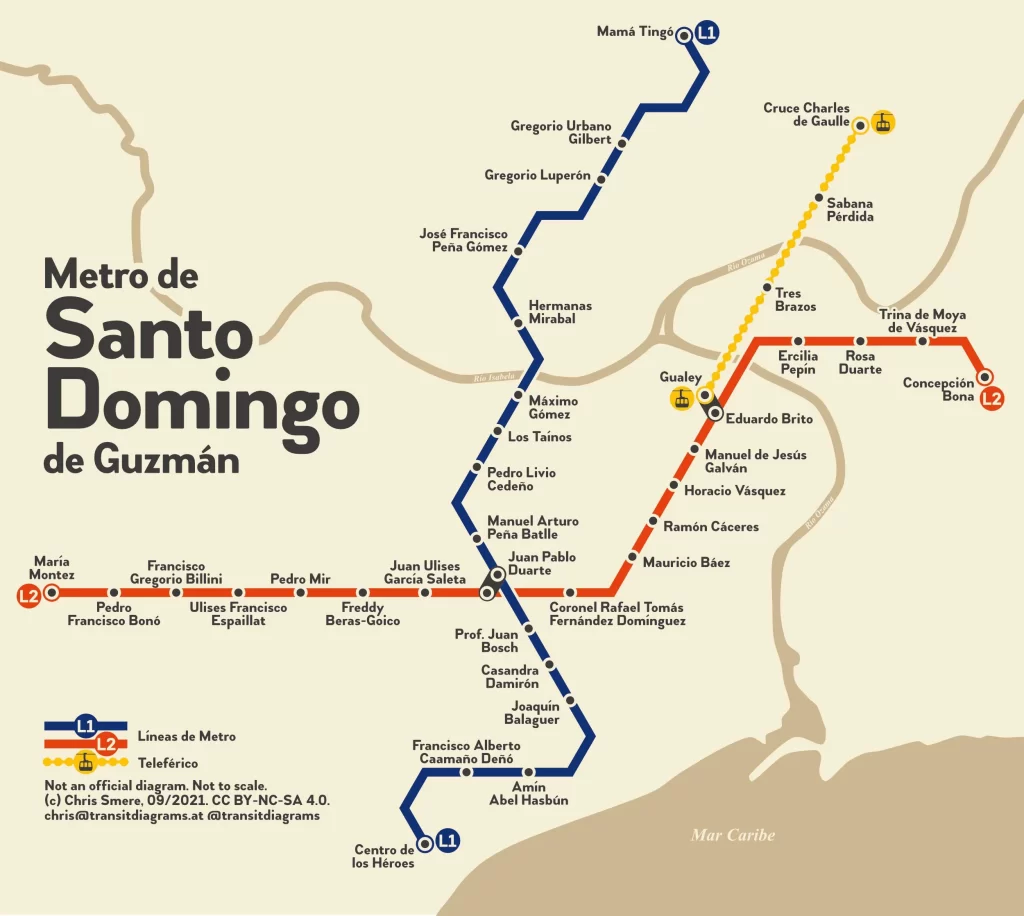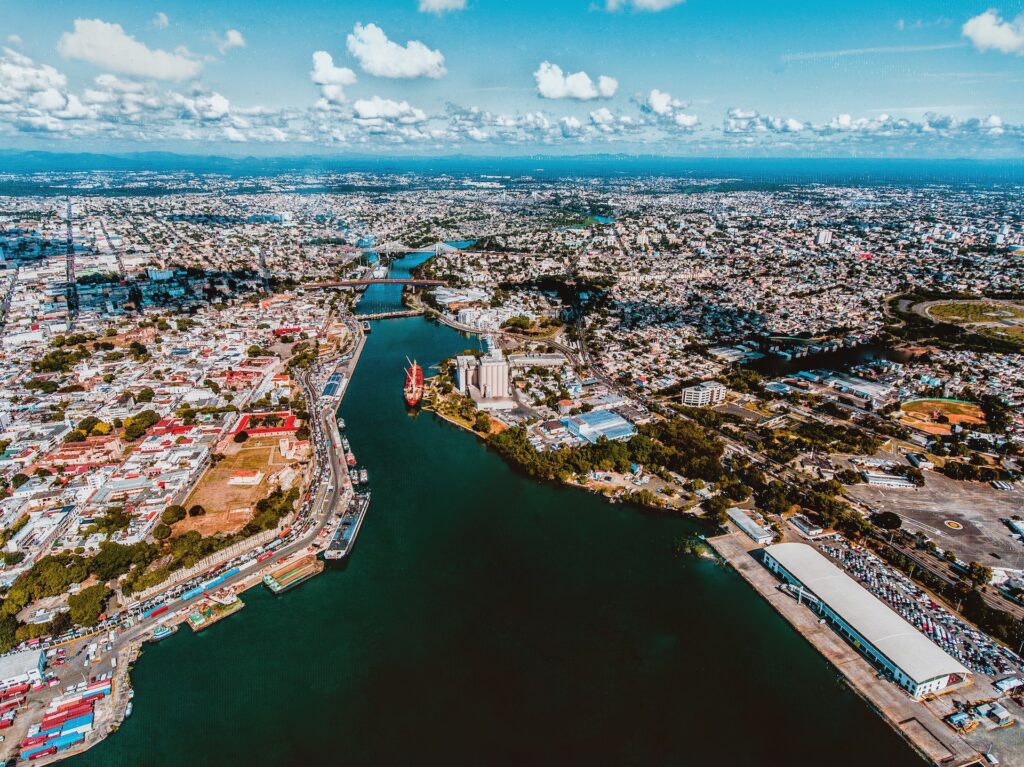Santo Domingo’s public transportation is reasonably priced and practical. There are other choices, including shared vans, buses, and taxis. The most common option is a taxi because they are easy to locate and allow you the most freedom. There are bus routes as well, however, they can get rather packed during rush hour. Locals frequently use shared vans, also known as Carros Publicos, which are a less expensive choice. The majority of public transit only accepts cash, so make sure to pack a few tiny dollars.
Basic information about the Metro system in Santo Domingo
The metro system in Santo Domingo is a modern and efficient way to travel around the city. It consists of two lines, Line 1 and Line 2, which are both connected to the city centre. The lines are 17.4 kilometers long in total, and there are 18 stations spread throughout the city. The metro system is usually very reliable and is a great way to get from one part of the city to another. The fare is relatively cheap, with one-way tickets costing around 25 Dominican Pesos. The metro system is also a great way to avoid traffic and get to your destination quickly.
The lines of the santo domingo subway system
The subway system in Santo Domingo is an important part of the city’s transportation system. It connects the city’s densely populated urban area to the rest of the country. More than 160,000 people use the two-line underground system every day.
The Universidad Autónoma de Santo Domingo and La Feria are served by Line 1, the city’s first underground line, which initially opened for service in 2009. There are 13 stops along this 8.5-kilometre-long railway. It goes through the middle of the city and connects the university area with the business and financial areas.
Between the stations of Expreso 27 de Febrero and the Universidad Autónoma de Santo Domingo, the Line 2 has been in operation since 2013. There are 14 stops along this 11.5-kilometer railway. It passes across the city’s eastern region and links the university district with the Los Alcarrizos and Av. Mirador Sur areas.
An essential component of the city’s public transit system is the underground system in Santo Domingo. It offers a speedy and simple means for individuals to get around the city, enabling them to quickly and comfortably get where they need to go.
Map of santo domingo Metro 2023 – Free Download in PDF

For individuals who want to learn more about the capital city of the Dominican Republic, the Map of Santo Domingo Metro 2023 is a helpful resource. You can quickly plan out your trip, find areas of interest, and traverse the city with the aid of this free PDF download. This map will assist you in navigating the city’s busy streets and finding its hidden jewels, whether you’re a local or a guest. You will have all the information you need to make your trip to Santo Domingo as enjoyable as possible, thanks to its detailed information, which includes station names, bus stops, and nearby attractions.
Public transport tickets in santo domingo – Best types for travelers & actual prices
The public transportation system in Santo Domingo, the capital of the Dominican Republic, is thriving and busy. Buses, taxis, the metro, and ferries are just a few of the transportation options available in the city. Given the range of choices, it’s critical to comprehend the many ticket categories and their associated prices.
The bus is the most popular form of public transportation in Santo Domingo. A single ticket costs 30 to 50 Dominican pesos, depending on the route and kind of bus. A book of ten tickets can be purchased for a reduced price, typically between 200 and 300 Dominican pesos. Although they can get very busy during peak hours, the buses are often quite reliable and frequent.
Taking a taxi around Santo Domingo is fairly usual. The price of a taxi ride depends on how far you’re going, but it’s usually between 50 and 100 Dominican pesos. You can reserve a cab in advance or just flag one down on the street.
The metro, Santo Domingo’s newest mode of public transportation, is a convenient method to move about the city. A single, cross-line ticket is available for 25 Dominican pesos. A book of 10 tickets can be purchased for a reduced price as well. The metro system is quick, effective, and frequently immaculate.
Ferries are the only other viable means of getting around Santo Domingo. Although they are the priciest mode of public transportation in the city, ferries can be an excellent way to see the coastline. Depending on the route, a single ticket might cost anything from 100 to 150 Dominican pesos.
In general, Santo Domingo offers a wide range of transportation options. There are many ways to get around the city, including buses, taxis, the metro, and ferries. Prices can vary depending on the type of transportation and the route taken, but they are usually not too high. Santo Domingo has something to offer everyone, whether you’re seeking the fastest method to navigate the city or just want to explore the shoreline.
Summary of fares for public transport in Santo Domingo
- Single bus tickets normally cost between 30 and 50 Dominican pesos, while a book of 10 tickets typically costs between 200 and 300 Dominican pesos.
- Taking a taxi is a common occurrence in Santo Domingo, with prices often ranging between 50 and 100 Dominican pesos.
- The metro is a cost-efficient, rapid, and handy mode of transportation. Single rides cost 25 Dominican pesos, and 10-ride books are available for a discount.
- The most expensive form of public transportation is the ferry, with single tickets costing between 100 and 150 Dominican pesos.
Timetables & Schedules of Santo Domingo Metro system
The Santo Domingo Metro system is open from 5 a.m. to 11 p.m. on Mondays through Saturdays. On Sundays and holidays, it is open from 7 a.m. until 9 p.m. With 31 stations and 2 lines, it provides a quick and easy method to move around the city. Depending on how far you go, you pay between 2 and 10 pesos. The lines are marked by colors and letters. The Metro is a safe way to get around the city because there are uniformed guards at the stations and in the cars. During peak hours, the Metro runs every few minutes, and off-peak hours, it runs every 10–15 minutes.
What Are Other Options For Public Transportation In santo domingo?
The capital of the Dominican Republic, Santo Domingo, is a bustling city of more than 3 million people. The city has recently seen an upsurge in infrastructural development, however, a metro system has not yet been implemented as part of this. Locals and visitors can still choose from a number of public transportation options, which is good.
The “gua gua” or “guagua” is the most often used form of public transportation in Santo Domingo. This shared minibus travels along predetermined routes and is the most cost-effective method of getting about the city. Although the buses are frequently full, they are quick and convenient. The cost varies from 10 to 25 pesos depending on the distance, and they can be flagged down on the street. Additionally, Santo Domingo has a network of privately run public buses. These buses cost between 15 and 30 pesos and are typically more comfortable than gua guas.
The “carrito” or “chiva,” a shared taxi service, is an additional choice. Although more expensive than gua gua, they provide a more relaxing and private experience. Fares begin at 25 pesos and increase in accordance with the distance. A variety of private cab services are also provided by the city. These are the most expensive options, with rates dependent on distance starting at 100 pesos.
There are also bike rental options accessible for people who want to tour the city at their own leisure. For those seeking a more environmentally responsible way to see the city and its surroundings, this is a fantastic option.
Santo Domingo provides both locals and visitors with a variety of public transportation alternatives. Everyone can find something they like, whether it’s a quick carrito or a cheap guacamole.
How To Get From Las Américas International Airport (sdq) To The City Center With Public Transport?
You’ve come to the right place if you’re seeking a cheap means of public transportation to get from Las Américas International Airport to the city center. We’ll provide step-by-step directions for doing it effectively in this guide.
Getting to the public transit system is the first action you must take. Head to the bus station, which is close to the terminal building, from the arrivals terminal. Purchase your public transportation ticket when you get there. The cost of a ticket varies based on where you are going, but it typically costs $1.50 USD.
As soon as you receive your ticket, get on the bus and ride it to the city centre. Before reaching the city centre, the bus will go through the Autopista Las Americas, passing via San Isidro, San Antonio de Los Baos, and San Miguel del Padrón. It should take an hour and a half to complete the trip.
You can choose from a number of public transit alternatives when you get to the city centre, including buses, taxis, and automobile services. Whichever choice best meets your needs will depend on where you’re going.
Public transportation is the most cost-effective method of traveling from Las Américas International Airport to the city centre. Just keep in mind to buy your ticket in advance, hop on the bus at the airport, and take in the view as it travels along the Autopista Las Americas. It is possible to travel to the city centre without incident with a little advance preparation.
What kinds of sights should you see if you’re visiting Santo Domingo for the first time?
The Dominican Republic’s capital, Santo Domingo, is where visitors may find a wide variety of attractions. There is something for everyone in Santo Domingo, from its beautiful colonial architecture to its lively culture and beautiful beaches. Here are a few of Santo Domingo’s best tourist destinations.
- The Zona Colonial a UNESCO World Heritage Site, is Santo Domingo’s historic core. Beautiful colonial-era buildings from the 1500s can be found all around the neighborhood, including the Catedral Primada de America, which is the oldest cathedral in the New World. The Zona Colonial is a great place to go sightseeing and get a taste of the local culture because it is also home to a number of museums, galleries, and plazas.
- The Malecon is a well-liked boardwalk that runs beside the Caribbean Sea. Both locals and tourists converge here to enjoy the ocean views, watch the sunset, and stroll along the beach. Along the Malecon, there are numerous eateries and bars, making it a fantastic place to get a bite to eat or unwind with a drink.
- Just outside of Santo Domingo, Montesinos Beach is a gorgeous white sand beach. There are several restaurants and pubs close by for when you want to get out of the sun, and the beach is great for swimming and sunbathing.
- Altos de Chavon is a well-liked destination for travellers to explore. It is a recreated 16th-century Mediterranean village situated along the Chavon River. A 5,000-seat amphitheatre for performances and concerts is located in the village along with a number of dining establishments and art galleries.
- Tourists of all ages enjoy visiting the National Aquarium of Santo Domingo. Numerous marine animals, including sharks, stingrays, and sea turtles, can be found at the aquarium. Visitors can participate in interactive activities and learn more about the local marine life.
Santo Domingo has much to offer, whether you’re seeking culture, beaches, or just a good time. There are many sights to discover in this dynamic city, including the majestic Zona Colonial, the lively Malecon, and the lovely beaches.
Summary of our tour guide for Santo Domingo
The capital of the Dominican Republic, Santo Domingo, is the biggest city in the Caribbean. The city is a popular place for tourists to visit because it has a rich history and culture. Santo Domingo has dependable and practical public transit, including buses, taxis, and vehicle rentals. The city’s public transit system is a fantastic way to get around because it is reliable and efficient. Additionally, the city features a vast network of bike lanes that make it simple to travel around on two wheels. Santo Domingo is easy and fun to explore because there are so many things to do there.
Top 5 FAQs and answers about Santo Domingo public transport?
- How should I go around Santo Domingo?
- The city’s public transit system is the greatest way to navigate around Santo Domingo. You can simply go to your desired location via buses, taxis, and trolleybuses, which are all readily available. With costs ranging from around 25 to 50 pesos (roughly $0.50 to $1.00 USD), they are all reasonably priced.
- Is Santo Domingo’s public transit secure?
- In general, Santo Domingo’s public transportation is secure. Travelers should always be mindful of their surroundings, though, and take the required safety precautions, just as they would in any large city. It is recommended to get off the bus or taxi and find another mode of transportation if you ever feel uneasy.
- What are the taxi and bus fares in Santo Domingo?
- Depending on the distance, bus prices in Santo Domingo range from 25 to 50 pesos. For a short trip, a taxi will normally run you about 500 pesos (about $10 USD), though costs can change depending on where you’re going.
- Are there any pointers for using Santo Domingo’s public transportation system?
- Yes, there are some things to remember when using Santo Domingo’s public transit. Always be cautious of your surroundings, and carry as few valuables as possible. Furthermore, it’s essential to have little notes on hand because some buses and taxis could demand precise change.
- Does Santo Domingo offer any other modes of transportation?
- In Santo Domingo, there are more modes of transportation than buses, taxis, and trolleybuses. Travelers who want to tour the city often choose private drivers, automobile rentals, or bicycle rentals.
Useful links
- Official website of public Santo Domingo transport company







